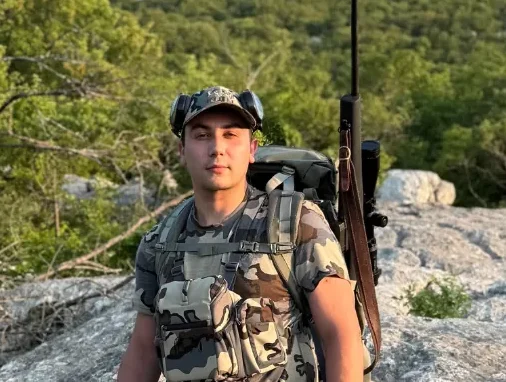You’re checking your trail cameras in February when you find them – roe deer carcasses scattered around your hunting area like someone played a deadly game of chance. Some look emaciated, others appear healthy but dead. Your mind starts racing: “Was it the brutal cold snap? Lack of food? Disease? Am I looking at natural mortality or something I could have prevented?”
Welcome to the harsh reality of winter deer management that separates experienced hunters from weekend warriors.
Here’s what most hunters get wrong about winter mortality: they blame the obvious suspects while missing the real killers. They see snow and immediately think “starvation,” or find a dead deer near a road and assume “vehicle strike.” Meanwhile, the actual causes – the ones you can actually influence as a landowner or hunter – fly completely under their radar.
I’ve watched hunters panic over mild winters while ignoring massive mortality events during seemingly “good” conditions. I’ve also seen guys throw thousands of dollars at supplemental feeding programs that actually increase winter deaths rather than prevent them.
💡 Winter mortality isn’t about battling Mother Nature – it’s about understanding which factors you can control, which ones you can’t, and when your good intentions are actually making things worse.
Let me walk you through what really kills roe deer in winter, what’s just natural selection doing its job, and when you’re looking at something that demands immediate action.
The Brutal Truth About Winter Selection
Before we dive into specific mortality causes, here’s the reality that makes most hunters uncomfortable: winter is supposed to kill deer. It’s not a management failure – it’s nature’s quality control system.
Roe deer populations naturally fluctuate based on winter severity, and those fluctuations are healthy. The deer that die in winter are typically the ones that wouldn’t have survived breeding season anyway – the sick, the weak, the genetically inferior, and the behaviorally stupid.
But here’s where it gets complicated: human activities have altered this natural selection process in ways most hunters don’t understand. We’ve created artificial food sources, altered habitat structure, changed predator dynamics, and introduced new mortality factors that can tip the balance from “natural selection” to “population crash.”
The key is learning to distinguish between the two.
What Actually Kills Roe Deer in Winter
Forget what you think you know about winter mortality. Most hunters have it backwards.
Starvation: The Myth That Won’t Die
This is where 90% of hunters get it wrong. They see a skinny dead deer in February and immediately blame lack of food. Wrong.
Healthy roe deer are incredibly efficient at surviving food shortages. They reduce their metabolic rate, become less active, and can survive on surprisingly little browse for extended periods. True starvation deaths are rare in areas with even marginal habitat.
What kills deer isn’t lack of calories – it’s lack of nutrition during pregnancy and lactation combined with parasitic loads that drain energy reserves. A doe can appear healthy while her unborn fawn is already doomed due to nutritional stress from the previous winter.
The deer you find “starved” in February probably died from complications that started the previous summer.
Predation: The Factor Everyone Ignores
Here’s what will shock most hunters: predation accounts for more winter roe deer mortality than starvation in most areas, but it’s largely invisible because predators clean up the evidence.
Winter predation patterns are completely different from summer kills. Deep snow forces deer into predictable travel corridors and concentration areas where predators can hunt more efficiently. Wolves, lynx, and even large birds of prey switch their hunting strategies to exploit winter-weakened deer.
The kicker? Human hunting pressure in autumn often pushes deer into winter ranges that are predator traps. That “sanctuary” area you’re so proud of protecting might be a killing field once snow flies.
Disease Amplification: When Winter Makes Everything Worse
Every pathogen roe deer carry becomes more dangerous in winter. Parasites that barely affect healthy deer in summer can kill weakened animals in winter. Respiratory infections that would clear up in good conditions become fatal when deer are stressed.
The real killer isn’t any single disease – it’s the cascade effect where winter stress compromises immune systems, allowing multiple pathogens to overwhelm deer simultaneously.
I’ve seen healthy-looking deer die from parasite loads that wouldn’t have bothered them three months earlier.
Weather: It’s Not What You Think
Extreme cold doesn’t kill healthy roe deer. They’re adapted for it. What kills them is the timing and duration of weather events relative to their energy reserves and behavioral patterns.
A warm December followed by brutal January conditions can be deadlier than consistent cold all winter because deer don’t enter full winter adaptation mode. Late spring storms that coat new growth with ice can trigger mass mortality events by removing the first fresh nutrition after winter stress.
The weather events that kill deer are usually the ones that disrupt their behavioral patterns or cut off food sources at critical moments.
The Human Factor: When Good Intentions Kill
This is where most hunters create problems while thinking they’re helping.
Supplemental Feeding: The Death Trap
Nothing kills more roe deer than well-intentioned supplemental feeding programs. Here’s why:
Artificial feeding creates unnaturally high deer concentrations, which accelerates disease transmission. Deer that should be spread across the landscape get crowded into small areas around feed sites, creating perfect conditions for pathogen spread.
Wrong feed types can kill deer faster than no feed at all. Corn, bread, and other high-carbohydrate feeds can cause fatal digestive disruption in deer adapted to winter browse. I’ve seen entire family groups die from well-meaning landowners who thought they were helping.
Even correct feed creates dependency that makes deer vulnerable when feeding stops or becomes unreliable.
Habitat Modification Gone Wrong
Hunters love to create food plots, but winter food plots are often death sentences for roe deer. Open fields that provide nutrition also create exposure to predators and weather that can offset any nutritional benefits.
Edge habitat – the boundary between forest and open areas that hunters love – becomes a predator highway in winter. Creating more edge often creates more mortality.
The Disturbance Factor
Winter-stressed deer have minimal energy reserves, and human disturbance forces them to burn calories they can’t replace. Snowmobile trails, hiking paths, and even wildlife photography in winter ranges can push deer over the survival threshold.
The “non-consumptive” outdoor activities that environmentalists promote can be more deadly to deer than hunting.
Field Signs: Reading the Story
When you find dead roe deer, the location and condition tell you everything about cause of death:
Starvation victims: Found in areas with depleted browse, obvious rib and hip bone protrusion, but often no external injuries. Rare in good habitat.
Predation kills: Usually partially consumed, found in travel corridors or near thick cover, signs of struggle, drag marks or scattered remains.
Disease deaths: May appear well-nourished externally but show signs of diarrhea, respiratory distress, or behavioral abnormalities before death. Often found near water sources.
Weather kills: Typically found in areas where deer sought shelter but couldn’t escape specific weather events. May appear healthy but succumbed to exposure during critical weather windows.
Human-caused mortality: Vehicle strikes show obvious trauma, feeding-related deaths often occur near artificial food sources with multiple animals affected.
The Timing Element
Winter mortality doesn’t happen randomly – it follows predictable patterns that experienced hunters learn to anticipate:
December-January: Early winter deaths are usually animals that entered winter already compromised. These are often natural selection events.
February-March: Peak mortality period when energy reserves are exhausted and deer are most vulnerable to all mortality factors.
April-May: Late winter/early spring deaths often result from exhaustion just before natural food becomes available. These are the most preventable deaths.
June-July: “Winter mortality” that shows up months later – fawns that died due to doe malnutrition during pregnancy.
What You Can Actually Control
Here’s where hunters can make a real difference versus where they’re just wasting time and money:
Habitat Quality (High Impact)
- Maintain diverse winter browse species
- Create thermal cover in appropriate locations
- Manage hunting pressure to avoid pushing deer into poor winter habitat
- Preserve natural travel corridors between seasonal ranges
Predator Management (Moderate Impact)
- Monitor predator populations in deer wintering areas
- Remove artificial attractants that concentrate deer where predators can exploit them
- Understand that complete predator removal is impossible and often counterproductive
Disease Prevention (Moderate Impact)
- Avoid artificial feeding that concentrates deer
- Report disease outbreaks immediately
- Don’t transport deer between areas during winter months
Direct Feeding (Negative Impact)
- Stop it. You’re probably killing more deer than you’re saving.
The Population Perspective
Individual deer deaths are tragic, but population-level thinking is what matters for management.
Winter mortality rates of 10-20% in roe deer populations are normal and healthy. Rates above 30% suggest management problems or unusual circumstances that need attention. Rates below 5% often indicate populations that are headed for summer range degradation and higher mortality later.
The goal isn’t to prevent all winter mortality – it’s to ensure that mortality is occurring for natural reasons rather than human-caused problems, and that surviving deer enter spring in condition to maintain population health.
When to Worry vs. When to Accept
Immediate management action needed:
- Mortality exceeding 30% of local population
- Deaths clustered around artificial food sources
- Disease symptoms in multiple dead animals
- Unusual mortality timing (early winter or late spring)
- Deaths clearly linked to human disturbance
Natural mortality to accept:
- Individual deaths of obviously compromised animals
- Mortality rates within normal ranges for local conditions
- Deaths following predictable winter patterns
- Predation on animals at normal population levels
Your responsibility: Learn to distinguish between the two.
The Management Reality
Winter mortality management is largely about not making things worse rather than actively preventing all deaths. The most effective winter deer management often involves doing less, not more.
Successful hunters understand that their role is to maintain habitat quality during the growing season, harvest appropriately in fall, and minimize disturbance during winter stress periods.
Everything else is either beyond your control or likely to backfire.
Your Choice This Winter
Every hunter faces the same decision when they find winter-killed deer: panic and start “helping,” or understand what’s actually happening and respond appropriately.
The panickers: Immediately start feeding programs, blame predators, demand wildlife agency intervention, and usually make mortality worse while feeling better about “doing something.”
The managers: Assess whether mortality is within normal ranges, identify actual causes rather than obvious scapegoats, address controllable factors, and accept that winter is supposed to be challenging for deer.
Winter mortality isn’t a management emergency – it’s a natural process that becomes a problem only when humans interfere with it inappropriately.
Which approach will you choose when you find your first winter-killed deer?
Good hunting.


